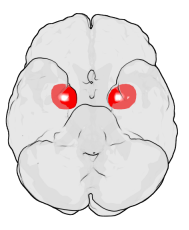March 24, 2016 report
Study suggests there is more to pain than amygdalae response

(Medical Xpress)—A team of researches affiliated with several institutions in the U.S. has found evidence that suggests that the human fear response is more complicated than a simple reaction in the amygdalae. In their paper published in the The Journal of Neuroscience, the researchers outline their study and results and offer some suggestions on other possible factors involved when people feel fear.
Fear is an unmistakable human condition, those feeling it have found themselves afraid of something, whether it is fear of being fired from a job, a physical threat or a combination of elements that result in a panic attack. After many years of research, scientists have found that the pair of small almond-shaped parts of the brain known as the amygdalae is where fear takes hold of us. But now, the researchers with this new effort have found that there may be other elements at play as well.
To learn more about what happens to people when experiencing fear, the researchers enlisted the assistance of adult female twins, both of whom have Urbach-Wiethe disease—a genetic disorder that prevents a person from experiencing fear—and another adult woman that did not have her amygdalae. All three women agreed to undergo experiments that were designed to instigate a fear response by causing a physical reaction that normally occurs when people feel fear. In the first experiment, an apparatus was affixed to their faces that caused them to breathe a mixture of gas high in carbon dioxide, which makes a person feel like they are suffocating. All three of the women demonstrated bodily reactions consistent with a fear reaction. In the second experiment, all three received injections of isoproterenol which causes a person to feel as if they have suddenly received a large dose of adrenaline. That caused one of the twins to experience a panic attack, a mild response in the other twin and response consistent with recognition of fear in the other woman.
These findings, the researchers suggest, indicate that there is more to fear than a simple reaction in the amygdalae—there are also bodily reactions that occur as well. And it seems possible that some instances of fear are actually emotional responses to bodily reactions, such as sudden loss of oxygen. They note that they had no explanation as to why the twins reacted differently to the same stimuli, but note that further studies with brains scans might help to clear things up.
More information: S. S. Khalsa et al, Panic Anxiety in Humans with Bilateral Amygdala Lesions: Pharmacological Induction via Cardiorespiratory Interoceptive Pathways, Journal of Neuroscience (2016). DOI: 10.1523/JNEUROSCI.4109-15.2016
Abstract
We previously demonstrated that carbon dioxide inhalation could induce panic anxiety in a group of rare lesion patients with focal bilateral amygdala damage. To further elucidate the amygdala-independent mechanisms leading to aversive emotional experiences, we retested two of these patients (B.G. and A.M.) to examine whether triggering palpitations and dyspnea via stimulation of non-chemosensory interoceptive channels would be sufficient to elicit panic anxiety. Participants rated their affective and sensory experiences following bolus infusions of either isoproterenol, a rapidly acting peripheral β-adrenergic agonist akin to adrenaline, or saline. Infusions were administered during two separate conditions: a panic induction and an assessment of cardiorespiratory interoception. Isoproterenol infusions induced anxiety in both patients, and full-blown panic in one (patient B.G.). Although both patients demonstrated signs of diminished awareness for cardiac sensation, patient A.M., who did not panic, reported a complete lack of awareness for dyspnea, suggestive of impaired respiratory interoception. These findings indicate that the amygdala may play a role in dynamically detecting changes in cardiorespiratory sensation. The induction of panic anxiety provides further evidence that the amygdala is not required for the conscious experience of fear induced via interoceptive sensory channels.
© 2016 Medical Xpress

















